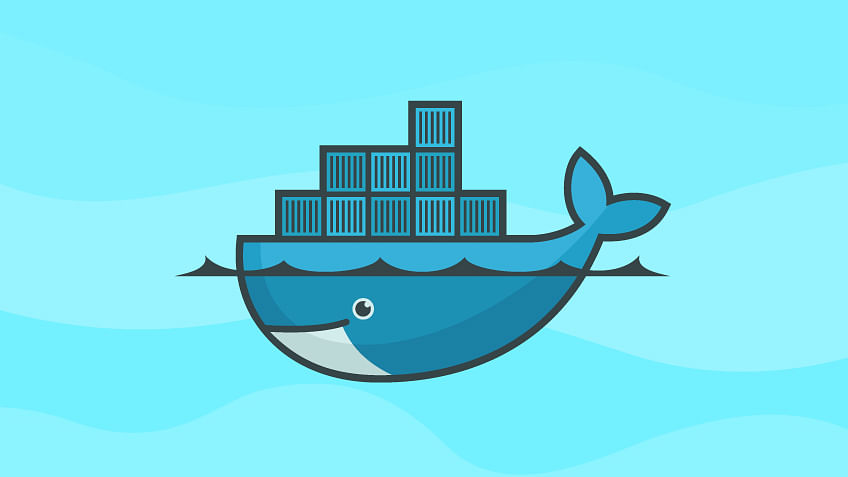In just the past few years, Docker’s popularity has greatly increased. The reason? It has changed the way software development happens. Docker’s containers allow for the immense economy of scale and have made development scalable, while at the same time keeping the process user-friendly.
Let's begin this "What is Docker" article by knowing what Docker actually is.
What is Docker?
When going through this Docker tutorial, we need to first understand about Docker. Docker is an OS virtualized software platform that allows IT organizations to easily create, deploy, and run applications in Docker containers, which have all the dependencies within them. The container itself is really just a very lightweight package that has all the instructions and dependencies—such as frameworks, libraries, and bins—within it.
The container itself can be moved from the environment to the environment very easily. In a DevOps life cycle, the area where Docker really shines is deployment, because when you deploy your solution, you want to be able to guarantee that the code that has been tested will actually work in the production environment. In addition to that, when you’re building and testing the code, having a container running the solution at those stages is also beneficial because you can validate your work in the same environment used for production.
You can use Docker in multiple stages of your DevOps cycle, but it is especially valuable in the deployment stage. Next up in this Docker tutorial is the advantages of Docker.
Now as you know what is Docker, you must know the difference between Docker and virtual machines. So, let’s begin.
Docker vs Virtual Machines
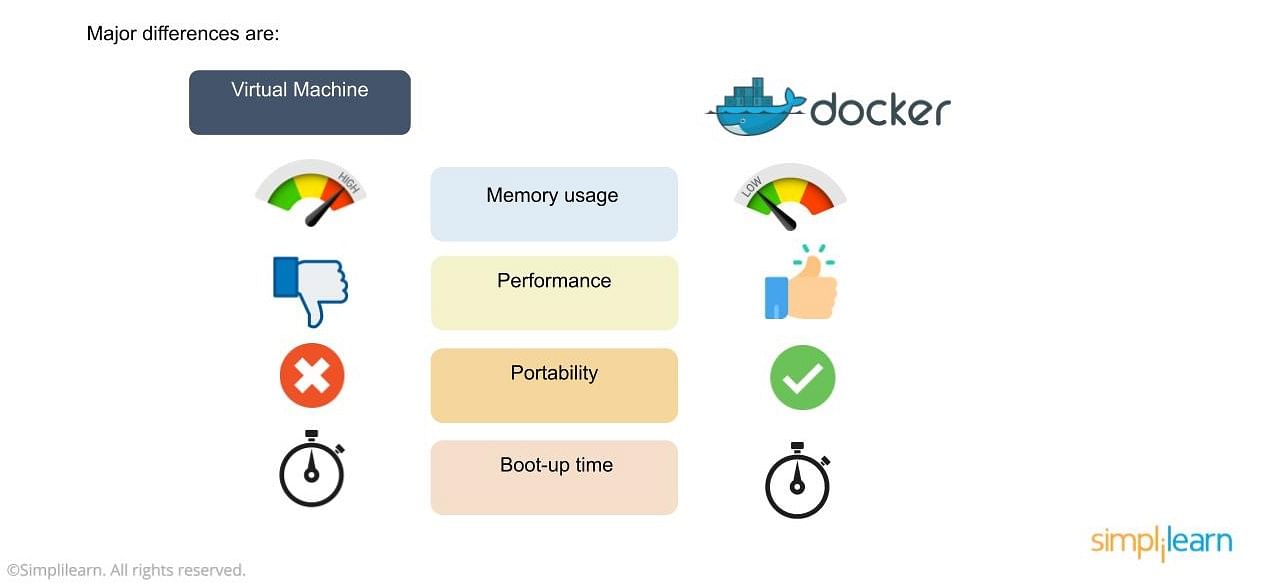
In the image, you’ll notice some major differences, including:
- The virtual environment has a hypervisor layer, whereas Docker has a Docker engine layer.
- There are additional layers of libraries within the virtual machine, each of which compounds and creates very significant differences between a Docker environment and a virtual machine environment.
- With a virtual machine, the memory usage is very high, whereas, in a Docker environment, memory usage is very low.
- In terms of performance, when you start building out a virtual machine, particularly when you have more than one virtual machine on a server, the performance becomes poorer. With Docker, the performance is always high because of the single Docker engine.
- In terms of portability, virtual machines just are not ideal. They’re still dependent on the host operating system, and a lot of problems can happen when you use virtual machines for portability. In contrast, Docker was designed for portability. You can actually build solutions in a Docker container, and the solution is guaranteed to work as you have built it no matter where it’s hosted.
- The boot-up time for a virtual machine is fairly slow in comparison to the boot-up time for a Docker environment, in which boot-up is almost instantaneous.
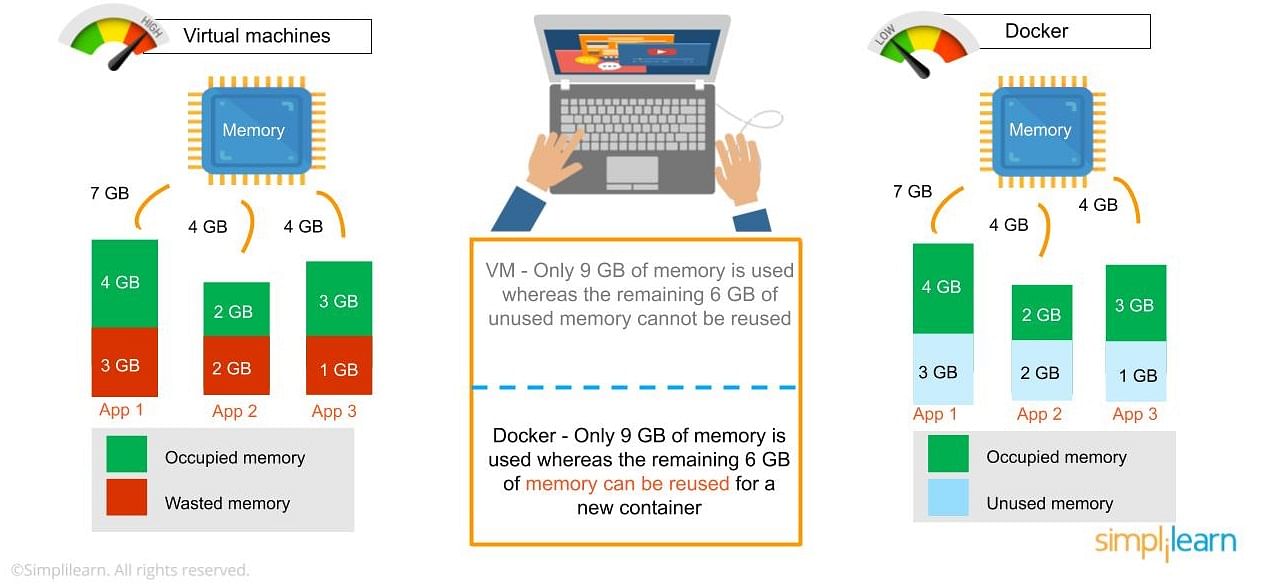
- One of the other challenges of using a virtual machine is that if you have unused memory within the environment, you cannot reallocate it. If you set up an environment that has 9 gigabytes of memory, and 6 of those gigabytes are free, you cannot do anything with that unused memory. With Docker, if you have free memory, you can reallocate and reuse it across other containers used within the Docker environment.
- Running multiples of them in a single environment can lead to instability and performance issues. Docker, on the other hand, is designed to run multiple containers in the same environment—it actually gets better with more containers run in that hosted single Docker engine.
- Virtual machines have portability issues; the software can work on one machine, but if you move that virtual machine to another machine, suddenly some of the software won’t work, because some dependencies will not be inherited correctly. Docker is designed to be able to run across multiple environments and to be deployed easily across systems.
- The boot-up time for a virtual machine is about a few minutes, in contrast to the milliseconds it takes for a Docker environment to boot up.
To get an in-depth knowledge of the differences between Docker and VM you can refer to our article here.
Advantages of Docker
Now we focus on the advantages of Docker, which is another important topic in our Docker tutorial. As noted previously, you can do rapid deployment using Docker. The environment itself is highly portable and was designed with efficiencies that allow you to run multiple Docker containers in a single environment, unlike traditional virtual machine environments.
The configuration itself can be scripted through a language called YAML, which allows you to describe the Docker environment you want to create. This, in turn, allows you to scale your environment quickly. But probably the most critical advantage these days is security.
You have to ensure that the environment you’re running is highly secure yet highly scalable, and Docker takes security very seriously. You’ll see it as one of the key components of the agile architecture of the system you’re implementing.
Now that you know the advantages of Docker, the next thing you need to know in this what is Docker article is how it works and its components.
How Does Docker Work?
Docker works via a Docker engine that is composed of two key elements: a server and a client; and the communication between the two is via REST API. The server communicates the instructions to the client. On older Windows and Mac systems, you can take advantage of the Docker Toolbox, which allows you to control the Docker engine using Compose and Kitematic.
Now that we have learned about Docker, its advantages, and how it works, our next focus in this article is to learn the various components of Docker.
Components of Docker
There are four components that we will discuss in this Docker tutorial:
- Docker client and server
- Docker image
- Docker registry
- Docker container
Docker Client and Server
This is a command-line-instructed solution in which you would use the terminal on your Mac or Linux system to issue commands from the Docker client to the Docker daemon. The communication between the Docker client and the Docker host is via a REST API. You can issue similar commands, such as a Docker Pull command, which would send an instruction to the daemon and perform the operation by interacting with other components (image, container, registry). The Docker daemon itself is actually a server that interacts with the operating system and performs services. As you’d imagine, the Docker daemon constantly listens across the REST API to see if it needs to perform any specific requests. If you want to trigger and start the whole process, you’ll need to use the Docker command within your Docker daemon, which will start all of your performances. Then you have a Docker host, which lets you run the Docker daemon and registry.
Now let’s talk about the actual structure of a Docker image in this article.
Docker Image
A Docker image is a template that contains instructions for the Docker container. That template is written in a language called YAML, which stands for Yet Another Markup Language.
The Docker image is built within the YAML file and then hosted as a file in the Docker registry. The image has several key layers, and each layer depends on the layer below it. Image layers are created by executing each command in the Dockerfile and are in the read-only format. You start with your base layer, which will typically have your base image and your base operating system, and then you will have a layer of dependencies above that. These then comprise the instructions in a read-only file that would become your Dockerfile.
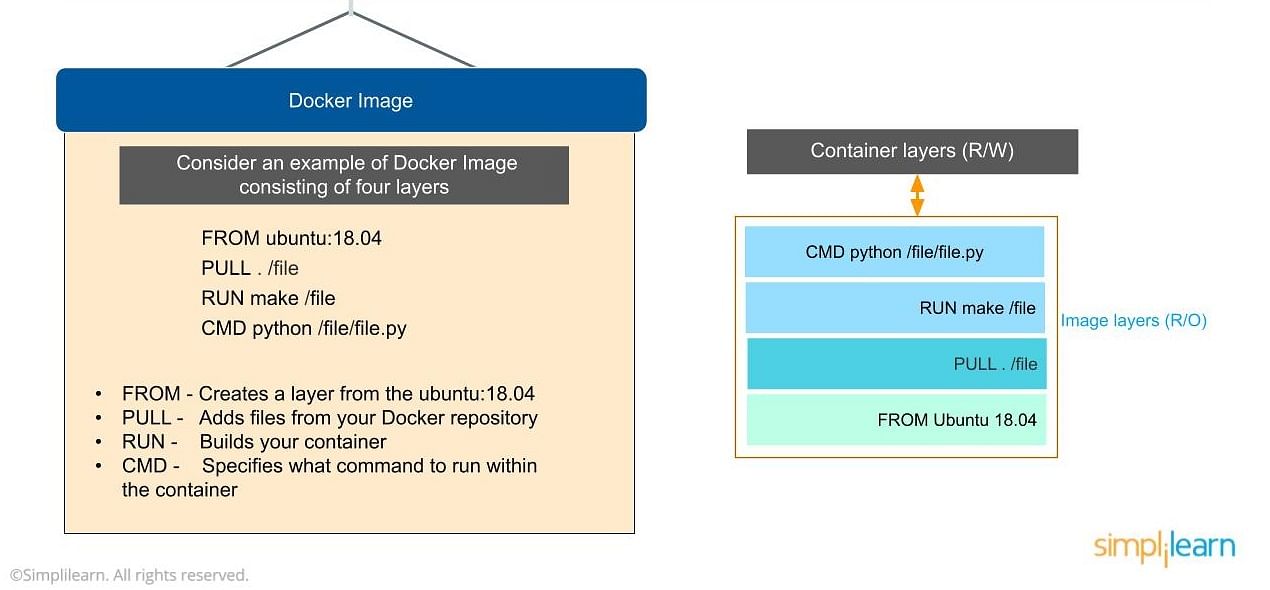
Here we have four layers of instructions: From, Pull, Run, and CMD. What do actually look like? The From command creates a layer based on Ubuntu, and then we add files from the Docker repository to the base command of that base layer.
- Pull: Adds files from your Docker repository
- Run: Builds your container
- CMD: Specifies which command to run within the container
In this instance, the command is to run Python. One of the things that will happen as we set up multiple containers is that each new container adds a new layer with new images within the Docker environment. Each container is completely separate from the other containers within the Docker environment, so you can create your own separate read-write instructions within each layer. What’s interesting is that if you delete a layer, the layer above it will also get deleted.
What happens when you pull in a layer but something changed in the core image? Interestingly, the main image itself cannot be modified. Once you’ve copied the image, you can modify it locally. You can never modify the actual base image.
Docker Registry
The Docker registry is where you would host various types of images and where you would distribute the images from. The repository itself is just a collection of Docker images, which are built on instructions written in YAML and are very easily stored and shared. You can give the Docker images name tags so that it’s easy for people to find and share them within the Docker registry. One way to start managing a registry is to use the publicly accessible Docker hub registry, which is available to anybody. You can also create your own registry for your own use internally.
The registry that you create internally can have both public and private images that you create. The commands you would use to connect the registry are Push and Pull. Use the Push command to push a new container environment you’ve created from your local manager node to the Docker registry, and use a pull command to retrieve new clients (Docker image) created from the Docker registry. Again, a Pull command pulls and retrieves a Docker image from the Docker registry, and a Push command allows you to take a new command that you’ve created and pushed it to the registry, whether it’s Docker hub or your own private registry.
Docker Container
The Docker container is an executable package of applications and its dependencies bundled together; it gives all the instructions for the solution you’re looking to run. It’s really lightweight due to the built-in structural redundancy. The container is also inherently portable. Another benefit is that it runs completely in isolation. Even if you are running a container, it’s guaranteed not to be impacted by any host OS securities or unique setups, unlike with a virtual machine or a non containerized environment. The memory for a Docker environment can be shared across multiple containers, which is really useful, especially when you have a virtual machine that has a defined amount of memory for each environment.
The container is built using Docker images, and the command to run those images is Run. Let’s go through the basic steps of running a Docker image in this tutorial on Docker.
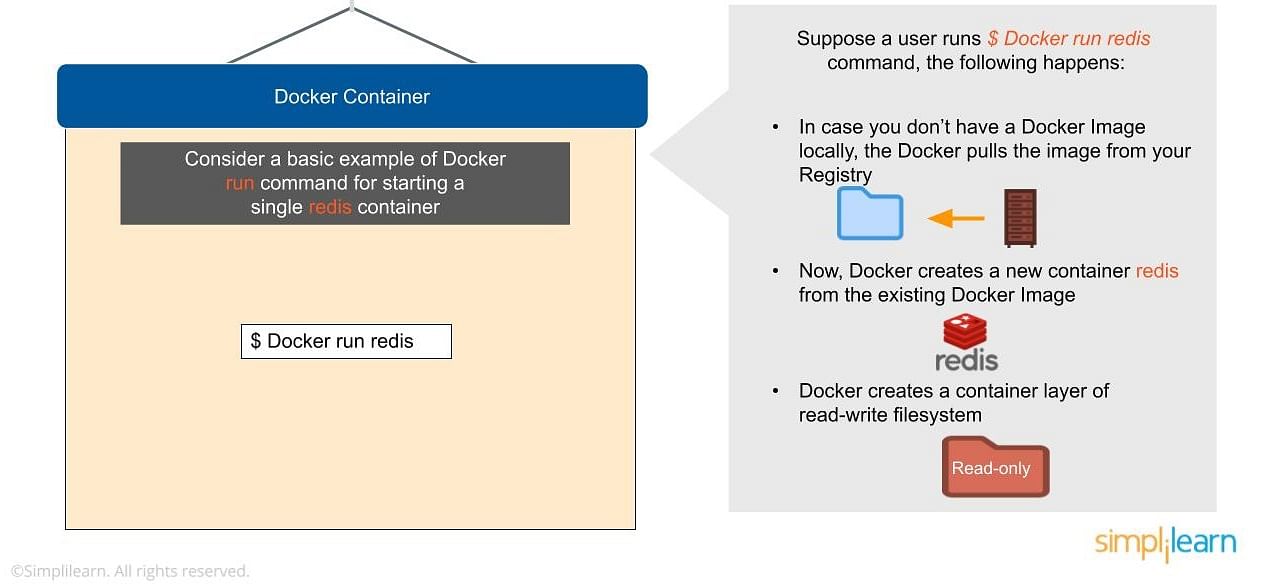
Consider a basic example of Docker run command for starting a single container called redis:
$ Docker run redis
If you don’t have the Redis image locally installed, it will be pulled from the registry. After this, the new Docker container Redis will be available within your environment so you can start using it.
Now let’s look at why containers are so lightweight. It’s because they do not have some of the additional layers that virtual machines do. The biggest layer Docker doesn’t have is the hypervisor, and it doesn’t need to run on a host operating system.
Now that you know the basic Docker components, let’s now look into advanced Docker components in this Docker article.
Advanced Docker Components
After going through the various components of Docker, the next focus of this Docker tutorial are the advanced components of Docker:
- Docker compose
- Docker swamp
Docker Compose
Docker-compose is designed for running multiple containers as a single service. It does so by running each container in isolation but allowing the containers to interact with one another. As noted earlier, you would write the compose environments using YAML.
So in what situations might you use Docker compose? An example would be if you are running an Apache server with a single database and you need to create additional containers to run additional services without having to start each one separately. ou would write a set of files using Docker compose to do that.
Docker Swarm
Docker swarm is a service for containers that allows IT administrators and developers to create and manage a cluster of swarm nodes within the Docker platform. Each node of Docker swarm is a Docker daemon, and all Docker daemons interact using the Docker API. A swarm consists of two types of nodes: a manager node and a worker node. A manager node maintains cluster management tasks. Worker nodes receive and execute tasks from the manager node.
After having looked into all the components of Docker, let us advance your learning in this article on the Docker commands and use case.
Conclusion
While this Docker article is just an overview, there are a great many uses for Docker, and it is highly valuable in DevOps today. To learn more on Docker or get a comprehensive Docker tutorial, check out our free resources and our Docker Certified Associate (DCA) Course.
